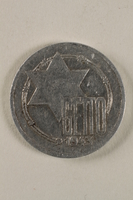Overview
- Description
- The photographic depicts Zgierska Street and the construction of the fence surrounding the ghetto in Łódź, Poland, a short time before the sealing of the ghetto.
Zgierska Street was renamed by the Germans to Hohensteinstrasse. The wall visible on the right in the photograph surrounded a Catholic church,"Wniebow stapienia Najswietzej Panny Marii," on 1 Plac Koscielny which was included in the ghetto. German authorities maintained a warehouse of property,"Federn und Daunen Sortieranstalt," confiscated from Jews deported to the Chelmno death camp. The driver of the carriage in the photograph is not wearing a Star of David which means that the photograph was taken before the sealing of the ghetto and that the driver was not Jewish. Dirt dug up to create holes used for the building of the fence that subsequently separated the ghetto from the city can be seen along the sidewalk. After April 30, 1940, there were only two horse-drawn carriages in the ghetto: one belonged to Mordechai Chaim Rumkowski, the chairman of the Jewish Council, and the other was the ambulance. Zgierska Street was open to"Aryan" streetcars, but the streetcars' doors and windows were tightly locked. The sidewalks belonged to the ghetto and were behind a barbed wire fence. Jerzy Flajszman lived on 9 Jerozolimska Street and had to cross the wooden bridge over Zgierska Street to reach the workshop on 56 Zgierska Street. The offices of KRIPO (Kriminal Polizei) were located on 4 Koscielna Street. Jews were forced to turn over all of their valuables like jewelry, radios, fur coats, and even dogs. - Date
-
1940
- Collection Creator
- Jerzy Flajszman
- Biography
-
Jerzy Flajszman (born Juda Ber Flajszman) was born on November 18, 1927, in Łódź, Poland. In February 1940, Jerzy, his mother, and his sister were forced into the Łódź ghetto. His father, Symcha, escaped to the Soviet Union where he survived World War II. Czarna Chawa and Chaja Sura Flajszman worked in the tailoring workshop (Schneider Abteilung) until September 1944 when they were deported to Auschwitz concentration camp and killed upon arrival. Jerzy worked in metal workshops (Metal Abteilung II) on Zgierska 56 in the Łódź ghetto. In August 1944 he was deported to the Auschwitz concentration camp. After a month and a half, he was transferred to Görlitz concentration camp (a sub-camp of Gross Rosen), where he worked in the “WUMAG” factory. The Soviet Army liberated him in May 1945. After liberation, he returned to his hometown of Lodz, Poland. In June 1951 he was married to Zofia Kolczycka. They emigrated from Poland to Sweden in 1969.
Physical Details
- Genre/Form
- Photographs.
- Extent
-
1 folder
Rights & Restrictions
- Conditions on Access
- There are no known restrictions on access to this material.
- Conditions on Use
- Material(s) in this collection may be protected by copyright and/or related rights. You do not require further permission from the Museum to use this material. The user is solely responsible for making a determination as to if and how the material may be used.
Keywords & Subjects
Administrative Notes
- Holder of Originals
-
United States Holocaust Memorial Museum
- Legal Status
- Permanent Collection
- Provenance
- The photograph was found by Jerzy Flajszman in the rubble of his house on 9 Jerozolimska Street in Łódź, Poland, after liberation in 1945 and was donated by Jerzy Flajszman to the United States Holocaust Memorial Museum in 1999.
- Record last modified:
- 2023-02-24 14:05:27
- This page:
- https://collections.ushmm.org/search/catalog/irn512829
Download & Licensing
- In Copyright - Use Permitted
- Terms of Use
- This record is not digitized and cannot be downloaded online.
In-Person Research
- Request 7 Days in Advance of Visit
- Plan a Research Visit
-
Request in Shapell Center Reading Room
Bowie, MD
Contact Us
Also in Jerzy and Zofia Flajszman collection
The collection consists of photographs, identification cards, a coupon, a wedding invitation, and a coin relating to the Flajszman and Kolczycki families in Łódź, Poland, before and during the Holocaust. Some of these materials may be combined into a single collection in the future.
Date: 1920-1945

Łódź (Litzmannstadt) ghetto scrip, 10 mark coin
Object
10 mark coin issued in the Łódź ghetto in Poland in 1943. Nazi Germany occupied Poland on September 1, 1940; Łódź was renamed Litzmannstadt and annexed to the German Reich. In February, the Germans forcibly relocated the large Jewish population into a sealed ghetto. All currency was confiscated in exchange for Quittungen [receipts] that could be exchanged only in the ghetto. The scrip and tokens were designed by the Judenrat [Jewish Council] and includes traditional Jewish symbols. The Germans closed the ghetto in the summer of 1944 by deporting the residents to concentration camps or killing centers.
Jerzy and Zofia Flajszman papers
Document
The papers consist of thirteen photographs, three identification cards, a coupon, and a wedding invitation relating to the Flajszman and Kolczycki families in Łódź, Poland, before and during the Holocaust.



